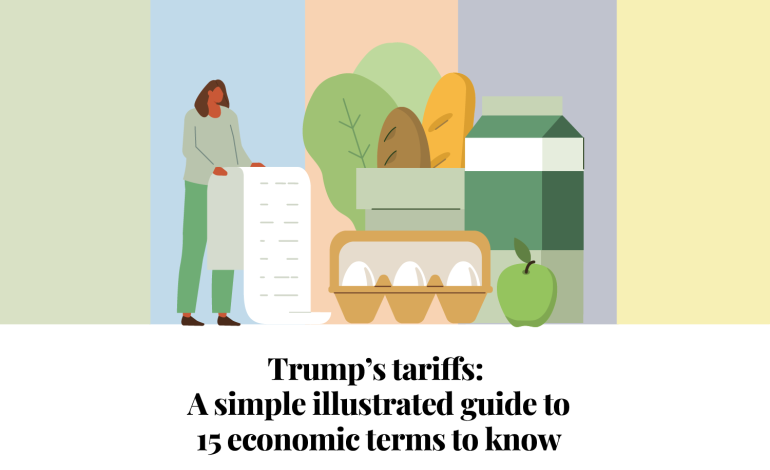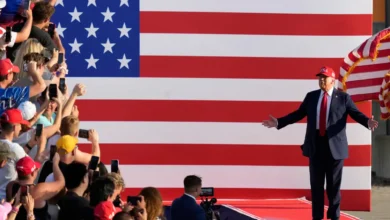Trump’s tariffs: A simple illustrated guide to 15 economic terms to know

Throughout the past few weeks, United States President Donald Trump has announced a series of tariff policies, with shifting statements that have led to growing concerns about global economic instability.
With Trump’s tariffs affecting nearly every country, many terms have been thrown around to describe the potential results.
From trade wars to stock market drops, this article explains, in simple terms with illustrations, what these key terms mean, including those that may become more important in the coming months.
1. Tariff
Tariffs are simply taxes imposed at the border by one country on the goods of a foreign country. They are usually aimed to protect local businesses from foreign competition.
Reciprocal tariffs have come to define Trump’s trade policy of imposing the same tariffs on other countries that those countries impose on US goods. It’s like saying, “If you charge us, we’ll charge you the same.”
Retaliatory tariffs are taxes imposed by a country on imported goods from a foreign country to strike back at that country’s imposition of similar taxes. It’s like saying, “If you make it hard for us, we’ll do the same to you.”
2. Trade war
A trade war occurs when, for example, two countries dispute trade practices and one country places extra tariffs on goods from another that it believes is engaging in unfair trade practices. The other country retaliates with tariffs and this tit-for-tat continues, thus escalating into a trade war.It’s like an economic tug-of-war where both sides keep pulling harder instead of finding a way to agree.
A good example is the US-China trade war, which has been in effect since 2018 when the US first placed tariffs on Chinese goods. More recently, the tit-for-tat between Washington and Beijing has seen tariffs on China rise to 145 percent.3. Trade deficit and surplus
A trade deficit occurs when a country buys (imports) more goods than it sells (exports), meaning the demand for foreign goods is greater than the supply of its own products.
For example, the US has a trade deficit with China because it buys more goods from China, like electronics and clothing, than it sells to it.A trade surplus is the opposite. This happens when a country sells more goods than it buys.
For example, the US has a trade surplus with The Netherlands because it sells more goods, like machinery and agricultural products, to the Netherlands than it buys from it.4. Subsidies
Subsidies are financial support or money given by the government to help local businesses or industries, making their products cheaper or more competitive.
For example, following Trump’s 25 percent tariff on all foreign automobiles and auto parts, South Korea announced emergency support for its auto sector by raising electric vehicles subsidies to boost demand.5. Stock market
The stock market is a place where shares of companies and other financial instruments are bought and sold. For example, if you buy Amazon shares, you’re owning part of the company, and the stock’s value can go up or down, meaning you can make or lose money.An index is a way to measure how a group of stocks is performing.
In the US, three of the biggest indices are:
S&P 500 tracks the 500 largest companies in the US.
Nasdaq Composite mainly tracks tech stocks such as Amazon and Google.
Dow Jones Industrial Average tracks 30 large US companies like Coca-Cola and Walmart.
6. The Fed
The Fed (short for the Federal Reserve) is the central bank of the United States.
It helps control the country’s money supply, sets interest rates, and tries to keep the economy stable – more on these later.7. Interest rates
Interest rates are the cost of borrowing money, usually expressed as a percentage.
For example, when the Fed raises interest rates, borrowing money becomes more expensive, and when it lowers rates, borrowing money becomes cheaper.
Interest rates go up when central banks want to slow inflation or cool down an overheating economy.8. Inflation
Inflation measures how quickly the price of things rises over time. This means that money doesn’t buy as much as it used to.
For example, if a sandwich cost $2.50 a year ago and now the same sandwich costs $3.00 then the inflation rate for the sandwich is 20 percent.
Inflation can occur when demand for a product is higher than supply, or when it costs more to make the product. It can also occur if there’s too much money in the economy, like when a country prints more cash.
The Fed tries to keep inflation steady. If prices rise too fast, it can hurt the economy by making goods and services too expensive. The Fed changes interest rates to help keep prices under control.









